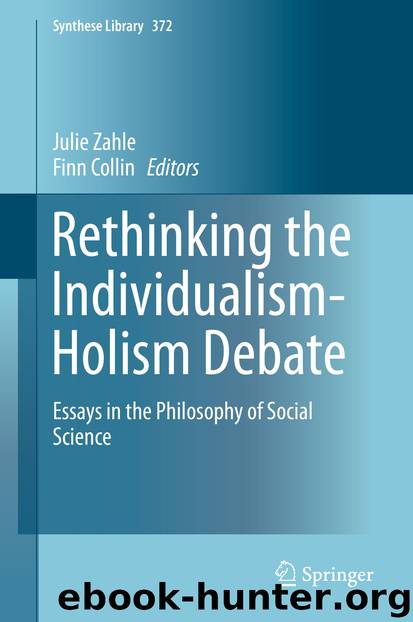Rethinking the Individualism-Holism Debate by Julie Zahle & Finn Collin

Author:Julie Zahle & Finn Collin
Language: eng
Format: epub
Publisher: Springer International Publishing, Cham
7.5 The Diversity of Social Macro Properties
One of the implicit assumptions of the traditional debate is that social macro properties are homogenous. When the debate is conducted at the abstract level of S and I predicates and without real social scientific examples, this may go easily unnoticed. For the same reason, people have not recognized that social macro facts are actually quite difficult to think of in terms of ‘higher’ and ‘lower’ levels. In this Section I describe how the scale-based approach could naturally replace the metaphorical -levels discussion.
The diversity of social macro properties is a quite unexplored area in philosophy of the social sciences. We do not have a satisfactory classification of different sorts of social macro properties. However, it is useful to have some sort of preliminary taxonomy of macro social facts. Thus I employ the classification proposed in Ylikoski (2012). While it is still an open issue whether this scheme is ultimately satisfactory, it can be used to demonstrate the heterogeneity of social macro properties and to make the case for the relative fruitfulness of the scale-based approach in analyzing their role in explanations.
Ylikoski (2012) classifies social macro properties into four classes: (1) the statistical properties of a population; (2) the networks of relations within a population; (3) the communal properties; and (4) the properties of organizations. In what follows, I will first briefly describe each case and consider how cogent the competing conceptualizations actually are in capturing their specifics.
When methodological individualists discuss social macro facts, they often have in mind the statistical properties of a population (Ylikoski 2012: 28–29). These describe the distributions and frequencies of properties within a given population. The facts about distributions describe how certain attributes are distributed among members of a population or how individuals with certain attributes are distributed among social positions and spatial locations. The facts about frequencies specify the attributes, behaviors, or beliefs that are typical, rare, dominant, or marginal within the population. These properties seem rather unproblematic. The are based on data that may be from pre-existing registers or which are derived from surveys. The data tell about the individual attributes, and the macro properties are inferred (or estimated) from these data points. Thus they are logically continuous with the individual attributes (Pettit 1993: 121). It is no wonder that individualists do not usually find these properties to be threatening. The only problem is with the individual properties themselves. For example, unemployment is an institutional status that cannot be understood as an intrinsic property of an individual. However, we can pass over this problem in the context here.
Is it possible to think about statistical properties in terms higher and lower levels? The first thing to note is that because statistical properties are in principle based only on an aggregation of individual properties, it would be easy to think of them as ‘individual-level’ properties. The problem is that while this stipulation gives an easy (partial) victory to the traditional individualist, it misses the contrast between micro and macro. Thus all micro-macro problems simply become invisible.
Download
This site does not store any files on its server. We only index and link to content provided by other sites. Please contact the content providers to delete copyright contents if any and email us, we'll remove relevant links or contents immediately.
| Biomathematics | Differential Equations |
| Game Theory | Graph Theory |
| Linear Programming | Probability & Statistics |
| Statistics | Stochastic Modeling |
| Vector Analysis |
Modelling of Convective Heat and Mass Transfer in Rotating Flows by Igor V. Shevchuk(6392)
Weapons of Math Destruction by Cathy O'Neil(6152)
Factfulness: Ten Reasons We're Wrong About the World – and Why Things Are Better Than You Think by Hans Rosling(4696)
Descartes' Error by Antonio Damasio(3232)
A Mind For Numbers: How to Excel at Math and Science (Even If You Flunked Algebra) by Barbara Oakley(3223)
Factfulness_Ten Reasons We're Wrong About the World_and Why Things Are Better Than You Think by Hans Rosling(3199)
TCP IP by Todd Lammle(3137)
Fooled by Randomness: The Hidden Role of Chance in Life and in the Markets by Nassim Nicholas Taleb(3049)
Applied Predictive Modeling by Max Kuhn & Kjell Johnson(3019)
The Tyranny of Metrics by Jerry Z. Muller(3005)
The Book of Numbers by Peter Bentley(2913)
The Great Unknown by Marcus du Sautoy(2651)
Once Upon an Algorithm by Martin Erwig(2602)
Easy Algebra Step-by-Step by Sandra Luna McCune(2585)
Lady Luck by Kristen Ashley(2535)
Practical Guide To Principal Component Methods in R (Multivariate Analysis Book 2) by Alboukadel Kassambara(2497)
Police Exams Prep 2018-2019 by Kaplan Test Prep(2488)
All Things Reconsidered by Bill Thompson III(2358)
Linear Time-Invariant Systems, Behaviors and Modules by Ulrich Oberst & Martin Scheicher & Ingrid Scheicher(2334)
